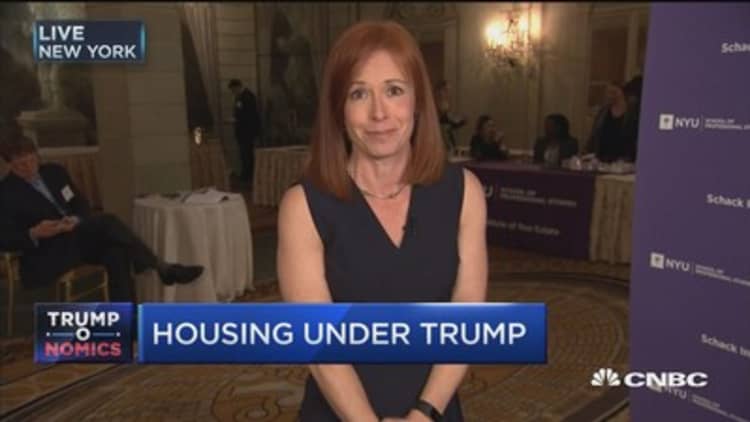Fixed-income investors can earn yields of nearly 10 percent, perhaps more, if they can overcome a 10-year aversion to mortgage-backed securities that were blamed for the financial crisis.
These high yields are offered by mortgage real estate investment trusts, or mREITs, a subset of the REIT universe. mREITs invest in mortgage-backed securities and other loans to homeowners and businesses, while equity REITs, the more common variety, own actual real estate — commercial, residential and industrial properties.
The National Association of Real Estate Investment Trusts (NAREIT) says yields on the 34 mREITs averaged 9.87 percent at the end of the first quarter, compared to 4.01 percent for equity REITs.
Brad Case, senior economist at NAREIT, says with mREITs currently yielding in excess of 7 points more than 10-year Treasury notes, they can be expected to return 8.9 percent a year over the next three years, based on patterns dating back to 1990.
mREITs can be a good choice for investors seeking steady income, as dividends from borrowers' payments are distributed to investors monthly rather than the longer intervals used by many fixed-income investments, says Allen Shayanfekr, co-founder of Sharestates, a real estate crowdfunding site.
Exchange-traded funds that specialize in mREITs, such as Market Vectors Mortgage REIT Income ETF (MORT) and iShares Mortgage Real Estate Capped (REM), are yielding 7.05 percent and 8.92 percent, respectively. ETF flows data shows that broad REIT funds are more popular. In the past one-year period, the Vanguard REIT ETF (VNQ) and iShares U.S. Real Estate ETF (IYR) have taken in $3.3 billion and $864 million, respectively. REM has taken in $348 million and MORT only $31 million, according to XTF.com.
(Source: National Association of Real Estate Investment Trusts)
There are risks, of course. mREIT dividends come from borrowers' loan payments, so a rise in defaults could drive yields down, taking mREIT shares down as well.
But advocates note that the economy is far healthier than in the financial crisis, when mortgage securities got a black eye. Loan defaults and unemployment have fallen, and home prices have gone up — reducing default risk.
Noted bond investor Jeff Gundlach of DoubleLine Capital is among the big names in the market who find mortgages attractive relative to other income opportunities.
"The market is stronger today than it was in the peak before the financial crisis," Shayanfekr says. However, he added that investors focused on long-term growth might do better in equity REITs, to profit from rising property values in addition to earning rental income.
More from ETF Strategist:
'Market crack': Leveraged ETFs ratchet up the risk again
ETFs are taking in more than $1 billion a day this year
The death of active funds explained in one article
Another hazard is "prepayment risk" when borrowers refinance their loans, stopping interest income on the old loans and returning investor's principal early — typically at a bad time to reinvest because yields are down. But prepayments are a major hazard only when interest rates are falling, and most experts think rates will continue to climb slowly, keeping this risk low.
Liquidity risk, or the prospect of not being able to buy or sell when you want to, is another concern, especially for investors trading in small volumes, says Steven N. Violin, senior vice president and portfolio manager at F.L. Putnam Investment Management Company in Wellesley, Massachusetts. Also, many mREITs bet on the spread between short- and long-term loan rates and use leverage to amplify results, making them especially hazardous if things go wrong.

Then there is interest-rate risk, when older, interest-paying securities lose value because investors prefer newer ones with higher yields.
"In today's market we are primarily concerned about interest-rate risk and particularly how companies will fare in a 'bear flattening' of the yield curve, where short-term interest rates rise faster than long-term rates," Violin said. "This can be something of a double whammy for mREITs, as it hurts asset values as well as dividends."
But many mREIT advocates say the danger is not serious if rate increases are gradual and don't go too high, since mREITS will gradually replace older securities with newer ones that are more generous. The Federal Reserve has said it will raise rates, but slowly and modestly.
Among individual mortgage securities, the yields can go significantly higher than the ETFs that invest in dozens of mREITS. Some examples of publicly traded mREITS with double-digit yields, from REIT.com:
- AGNC Investment Corp (AGNC): 10.54 percent
- Annaly Capital Management (NLY): 10.27 percent
- Chimera Investment (CIM): 10.31 percent
- CYS Investments (CYS): 11.79 percent
- Drive Shack (DS): 11.88 percent
- Dynex Capital (DX): 10.43 percent
- New Residential Investment (NRZ): 11.33 percent
- Western Asset Mortgage Capital (WMC): 11.81 percent
"Mortgage REITS are generally stable investments in a rising interest-rate market," Shayanfekr said. But that doesn't guarantee good times, as the expected rise in mREIT yields can be dampened if higher mortgage rates cut the pace of lending, causing a shortage of new loans with higher yields. "As rates increase, it's true that the overall yield will increase, but you'll also see a decrease in home values and likely fewer qualified borrowers, meaning less mortgage loan product," he said.
Investors can protect themselves from interest-rate risk by purchasing mREITs that invest in adjustable-rate loans, since interest rates on those will go up as rates rise, increasing the mREIT yield. Examples include issues among commercial REIT and residential mortgage REIT niches:
- Blackstone Mortgage Trust (BXMT): 8.09 percent
- Starwood Property Trust (STWD): 8.54 percent
- AGNC Investment (AGNC): 10.54 percent
- AG Mortgage Investment Trust (MITT): 10.12 percent.
"Rising home-loan rates tend to benefit mREITs that hold floating-rate loans," Violin said. "We prefer the commercial real estate loan segment in particular, where floating-rate securities are more readily available and yields seem relatively attractive in some sub-segments."
Christopher Dukes, president of Dukes Wealth Management, based in Culver City, California, is also a fan of mREITS containing floating-rate loans but prefers those that own residential rather than commercial loans, because he finds residential loans can adjust to rising rates more quickly.
"I've seen returns in the 5-6.5 percent range in early 2017," he said. "Given that many fixed rate investments pay considerably less, this asset class is a nice addition for someone looking for income. ... Investors should expect a five to seven-year time frame to maximize return on their investment."
— By Jeff Brown, special to CNBC.com




